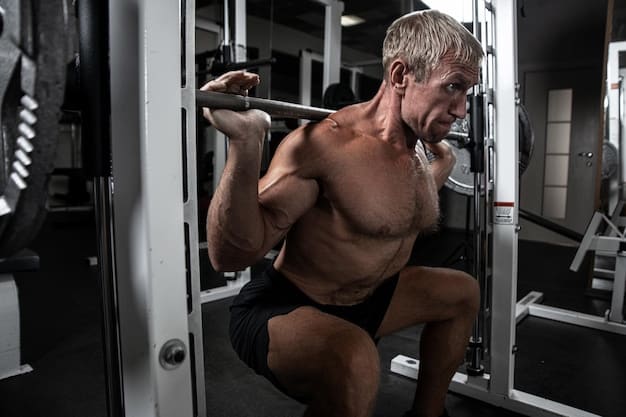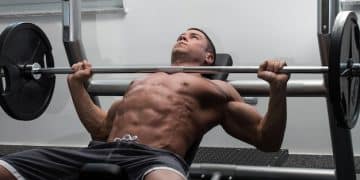Compound Exercises Only? Pros and Cons for Mass Building

Focusing solely on compound exercises for mass building offers unparalleled benefits in efficiency and functional strength, yet it requires careful consideration of potential muscle imbalances and recovery demands to optimize growth and prevent injury.
In the relentlessly evolving landscape of fitness, discussions often circle back to fundamental principles. One such debate, perennially sparked among enthusiasts and experts alike, centers on a core question: can focusing exclusively on compound exercises only? The pros and cons for building mass. This isn’t merely an abstract query; it delves into the very efficacy of training methodologies, challenging conventional wisdom and inviting a deeper look at how bodies respond to different stimuli.
the foundational role of compound movements
Compound exercises, by definition, are movements that involve multiple joints and muscle groups working together simultaneously. Think of the squat, deadlift, bench press, overhead press, and rows. These are the cornerstones of strength training, often lauded for their efficiency and their ability to recruit a significant amount of muscle mass in a single movement. Their appeal lies in their mimicry of natural human movement patterns, translating directly to improved functional strength and athletic performance.
When considering mass building, the principle of progressive overload is paramount. Compound movements are particularly well-suited for this, allowing individuals to lift heavier loads over time as their strength increases. This heavier lifting, in turn, puts greater mechanical tension on the muscle fibers, which is a primary driver of hypertrophy. The systemic stress induced by these exercises also contributes to a more robust hormonal response, including increased release of growth hormone and testosterone, both crucial for muscle growth and recovery. Furthermore, the coordination and stability required for these complex movements lead to enhanced neuromuscular efficiency, which means your brain gets better at signaling your muscles to work harder and more effectively.
However, it’s also important to understand that while compound movements are incredibly effective, they demand a higher degree of technical proficiency. Poor form can not only diminish their effectiveness for muscle growth but also significantly increase the risk of injury. Mastering these lifts requires patience, dedication, and often, guidance from experienced coaches. For beginners, the learning curve can be steep, but the investment in proper form pays dividends in long-term progress and safety. Anecdotal evidence from countless lifters, and strong scientific backing, consistently points to compound lifts as superior for overall strength and foundational muscle development.

the undeniable pros of a compound-focused approach
The advantages of building a training program primarily around compound exercises are numerous and compelling, especially when the goal is to optimize muscle mass and overall strength. These benefits extend beyond just muscle hypertrophy, encompassing systemic adaptations that are vital for comprehensive physical development.
maximal muscle recruitment and metabolic stress
One of the most significant pros is their ability to recruit a large volume of muscle mass simultaneously. Exercises like squats engage not only the quadriceps, hamstrings, and glutes but also the core, back, and calves for stabilization. This widespread muscle activation leads to greater overall metabolic stress and muscle damage, two key mechanisms for muscle hypertrophy. The more muscle fibers that are subjected to training stimulus, the greater the potential for growth. This efficiency means that you can achieve a profound training effect in less time, making compound movements ideal for individuals with limited time for gym sessions.
enhanced systemic hormonal response
Lifting heavy with compound movements triggers a robust physiological response. Studies have consistently shown that exercises involving large muscle groups and heavy loads lead to greater acute increases in anabolic hormones such as testosterone and growth hormone. While the direct long-term impact of these acute surges on muscle growth is still debated, they undeniably contribute to an environment conducive to anabolism and recovery. This systemic effect benefits overall body composition, not just the muscles directly targeted.
superior functional strength and athleticism
Unlike isolation exercises that target individual muscles in a controlled manner, compound movements train your body to work as a cohesive unit. This functional carryover is invaluable for everyday activities, sports, and overall physical prowess. The strength gained from squats translates to better jumping ability, deadlifts improve lifting mechanics, and presses enhance pushing power. For an athlete, a strong foundation in compound lifts is critical for performance enhancement and injury prevention. For the general population, it means improved quality of life and reduced risk of musculoskeletal issues.
- Time Efficiency: Get a full-body workout with fewer exercises.
- Greater Caloric Expenditure: Burn more calories due to higher muscle activation.
- Improved Bone Density: Weight-bearing compound lifts strengthen bones.
- Enhanced Coordination: Develop better inter-muscular and intra-muscular coordination.
Beyond these physical benefits, compound movements also foster a strong mind-muscle connection and resilience. The mental fortitude required to push through heavy sets builds character and discipline, attributes that transcend the gym environment. They are the true measures of strength, pushing your physiological limits and forcing adaptations that lead to significant gains in both size and power.
the potential cons and limitations to consider
While the benefits of a compound-centric training philosophy are clear, it’s equally important to acknowledge the potential downsides and limitations. A singular focus on compound exercises, without proper consideration for individual needs and specific goals, can present certain challenges. Understanding these cons allows for a more nuanced and ultimately more effective training approach.
risk of muscle imbalances and aesthetic gaps
One of the primary concerns with an exclusive reliance on compound movements is the potential for developing muscle imbalances. While these exercises are excellent for overall muscle growth, they may not optimally target every muscle within a given group or ensure balanced development. For instance, while squats work the quads and hamstrings, they might not develop the inner thigh muscles or certain parts of the glutes to the same extent that specific isolation exercises could. Over time, neglecting these smaller, supporting muscles can lead to imbalances that not only affect aesthetics but also increase vulnerability to injury. Similarly, certain aesthetic goals, such as maximizing bicep peak or tricep sweep, might be difficult to achieve without dedicated isolation work, as compound movements prioritize overall strength over specific muscle shaping.
higher demand for recovery and injury risk
The very nature of compound exercises — involving multiple joints and heavy loads — places a significant demand on the central nervous system and overall recovery capacity. Training exclusively with these movements, especially at high intensities and volumes, can quickly lead to overtraining if not managed carefully. The systemic fatigue accumulated can impair performance, hinder muscle growth, and increase the risk of injury. Moreover, the technical complexity of lifts like the deadlift or squat means that improper form can lead to acute injuries, particularly to the lower back, knees, or shoulders. Without sufficient rest, proper nutrition, and meticulous attention to form, the benefits can be overshadowed by setbacks. It’s a fine line between optimal stimulus and excessive stress.
difficulty in targeting specific muscle weaknesses
If an individual has a specific muscle weakness or lagging body part, relying solely on compound exercises might not be the most efficient way to address it. For example, if someone has weak triceps, their bench press might be limited by this weakness, preventing them from effectively overloading their chest. In such cases, incorporating isolation exercises specifically for the triceps can help bring that muscle group up to par, which in turn can lead to improved performance in compound lifts. Purely compound training may not provide the precise stimulus needed for targeted development or rehabilitation of specific muscle groups, leading to frustrating plateaus and persistent weak links. The nuance lies in recognizing when a compound exercise isn’t adequately stimulating a particular muscle due to a stronger adjacent muscle taking over the load.
These cons highlight that while compound exercises are incredibly powerful, they are not a panacea for all training goals. A truly holistic approach often integrates them with strategic isolation work, ensuring balanced development, addressing weaknesses, and managing recovery effectively.
striking the balance: integrating isolation work
Given the pros and cons discussed, the most effective approach for many individuals seeking to build significant muscle mass is not an “either/or” but rather an “and” strategy: integrating both compound and isolation exercises strategically. This hybrid model allows lifters to harness the power of compound movements while simultaneously addressing specific muscle development, imbalances, and aesthetic goals.
the synergistic relationship between compound and isolation
Think of compound exercises as the primary drivers of growth and strength, laying the foundational muscle mass and improving overall athletic capacity. Isolation exercises, then, act as finishers, shapers, and rectifiers. For instance, a heavy set of squats will build massive quads and glutes, but a leg extension can further engorge the quads with blood, enhance the mind-muscle connection to that specific muscle, and promote localized hypertrophy. Similarly, a bench press builds a strong chest, but flyes can stretch the pec muscle fibers and contribute to a fuller, more defined look. This synergistic relationship means that the whole is greater than the sum of its parts. Compound lifts provide the systemic growth stimulus, while isolation movements refine and maximize the development of individual muscles.
addressing lagging body parts and improving form
Isolation movements are invaluable for bringing up lagging body parts or strengthening specific muscles that might be weak links in compound lifts. If your triceps are holding back your bench press, direct tricep work can strengthen them, allowing you to lift heavier on the compound movement. Moreover, isolation exercises can sometimes be used to improve the mind-muscle connection for a particular muscle group. By focusing solely on contracting one muscle, you can learn to feel it working, which can then translate to better activation during compound movements. This selective targeting ensures that no muscle group is left underdeveloped or becomes a limiting factor in overall progress. It’s about building a robust chain, where every link is strong.
The key to effective integration lies in careful program design. Compound exercises should typically be performed earlier in a workout when energy levels are highest, allowing for maximum strength and performance. Isolation exercises can then follow, serving as supplementary work to increase volume, address specific muscles, and enhance the pump. The volume and intensity of isolation work should be adjusted based on recovery capacity and specific goals, ensuring it complements, rather than detracts from, the heavy lifting. This balanced approach ensures comprehensive muscle development, reduces the risk of imbalance-related injuries, and allows for greater aesthetic refinement, creating a physique that is both strong and well-proportioned.
Ultimately, a smart training program leverages the strengths of both types of movements. For someone whose primary goal is mass, compound exercises will always be the backbone, but isolation work provides the crucial detailing and ensures no muscle is left behind.
progression strategies for long-term mass building
Regardless of whether one opts for a pure compound approach or a hybrid model, the principle of progressive overload remains central to long-term mass building. Muscle growth is an adaptive response to stress, and for that adaptation to continue, the stress must consistently increase over time. This isn’t just about lifting heavier weights; it encompasses a variety of strategies that challenge the muscles in new ways, ensuring continuous progress and hypertrophy.
systematic weight increases and volume manipulation
The most straightforward method of progressive overload is to gradually increase the weight lifted on compound exercises. Once you can comfortably perform your prescribed reps with good form, it’s time to add a small amount of weight. However, progression isn’t linear. There will be plateaus, and that’s where other strategies come into play. Manipulating volume, by increasing the number of sets or reps, can also provide a new stimulus. For example, if you’ve been doing 3 sets of 5 reps, try moving to 4 sets of 5, or 3 sets of 8, while maintaining the same weight. This increases the total work performed, forcing your muscles to adapt and grow. Beyond just reps and sets, the concept of training to failure, or close to it, ensures that the muscle is fully stimulated at the end of a set.
advanced techniques and exercise variation
As you become more experienced, incorporating advanced training techniques can help break through plateaus and provide novel stimuli. Drop sets, where you reduce the weight immediately after reaching failure and continue performing reps, can extend a set and increase metabolic stress. Supersets, performing two exercises back-to-back with no rest, can increase workout density. Rest-pause training, taking short breaks within a set to eke out more reps, is another effective method. However, these techniques should be used sparingly and strategically, as they are highly demanding on the recovery system. Additionally, varying exercises, while keeping movements in the compound category, can prevent adaptation. Switching from barbell squats to front squats, or conventional deadlifts to sumo deadlifts, can target similar muscle groups in slightly different ways, promoting continued growth without stagnation. This variation prevents the body from becoming too accustomed to a single movement pattern.
- Increase Frequency: Train a muscle group more often.
- Decrease Rest Periods: Perform more work in less time.
- Improve Form: Lifting the same weight with better form is still progression.
- Time Under Tension: Slowing down eccentric portions of a lift.
The overarching goal of any progression strategy is to continually challenge the muscles beyond their current capacity, forcing them to adapt by growing larger and stronger. Consistency is key, but so is smart programming that incorporates varied forms of overload, allowing for long-term, sustainable gains in muscle mass without overtraining or burnout. Listening to your body, recognizing when to push and when to back off, is an essential element of this continuous progression.
nutrition, recovery, and lifestyle for optimal growth
Training intensely with compound exercises is only one piece of the mass-building puzzle. Without adequate nutrition, proper recovery, and a supportive lifestyle, even the most perfectly executed training program will yield suboptimal results. These elements are not merely supplementary; they are foundational pillars upon which muscle growth is built, determining the body’s ability to repair, adapt, and grow in response to the training stimulus.
the critical role of macronutrients and caloric surplus
To build muscle mass, the body needs a consistent supply of raw materials, primarily in the form of adequate calories and macronutrients. A caloric surplus, meaning consuming more calories than you burn, is essential for hypertrophy, as it provides the energy required for muscle protein synthesis and recovery. Protein intake is paramount, as it provides the amino acids necessary for muscle repair and growth. Aim for at least 1.6 to 2.2 grams of protein per kilogram of body weight. Carbohydrates are equally vital, serving as the primary fuel source for intense workouts and replenishing muscle glycogen stores, which are crucial for energy and recovery. Fats, often overlooked, are important for hormone production, nutrient absorption, and overall health. Prioritizing whole, unprocessed foods from all macronutrient groups ensures a steady supply of vitamins, minerals, and micronutrients that support all bodily functions, including those related to muscle growth. Hydration is also a non-negotiable component as water plays a critical role in cellular function and overall metabolism.
sleep and stress management: the silent builders
Muscle growth primarily occurs outside the gym, specifically during periods of rest and sleep. It is during deep sleep cycles that the body produces the most growth hormone, repairs damaged muscle tissue, and replenishes energy stores. Aim for 7-9 hours of quality sleep per night. Consistent sleep deprivation can significantly impair recovery, increase cortisol levels (a catabolic hormone), and hinder muscle protein synthesis. Beyond sleep, managing stress is crucial. Chronic stress, whether from work, personal life, or overtraining, elevates cortisol, which can break down muscle tissue and impede progress. Incorporating stress-reducing activities like meditation, light walks, or spending time in nature can have a profound impact on recovery and overall well-being. The body perceives all forms of stress similarly, and mitigating it outside the gym allows for better adaptation to the stress of training.
Lifestyle choices, such as avoiding excessive alcohol consumption and smoking, further contribute to an optimal anabolic environment. Alcohol can disrupt sleep, impair protein synthesis, and dehydrate the body, all of which are detrimental to muscle growth. Smoking reduces oxygen delivery to muscles and impairs circulation, hindering recovery and performance. Conversely, embracing an active lifestyle beyond simply lifting weights, which includes movement throughout the day and engaging in hobbies that support mental well-being, fosters a state of holistic health conducive to sustained muscle building. Prioritizing these elements outside of actual training sessions creates the fertile ground upon which hard-earned gains can truly flourish, transforming a consistent workout routine into measurable and lasting physical transformation.
individualization and listening to your body
Finally, it is paramount to recognize that what works for one individual may not work for another. The human body is a complex system, and training responses are highly individualized. Genetic predispositions, training experience, lifestyle factors, recovery capacity, and specific goals all play a significant role in determining the optimal training approach. Therefore, blindly following a regimen or dogmatically sticking to a “compounds only” mantra without considering personal context can be counterproductive, leading to stagnation, frustration, or even injury. The principle of individualization is not just a theoretical concept; it is the cornerstone of sustainable and effective long-term progress in any fitness endeavor.
adapting to unique responses and evolving goals
Every individual responds differently to various training stimuli. Some people might thrive on high-volume compound work, experiencing rapid gains, while others might find it too taxing on their recovery and benefit more from a lower volume, higher intensity approach, or more integrated isolation work. This necessitates a process of self-experimentation and detailed tracking. Pay close attention to how your body responds to different exercise selections, set and rep schemes, and rest periods. Are you recovering adequately? Are your strength levels increasing? Are you feeling good, or are you consistently fatigued? The answers to these questions should guide your programming decisions. Furthermore, goals evolve over time. While mass building might be the primary objective initially, it might later shift towards strength, endurance, or aesthetic refinement. A rigid “compounds only” mindset might not serve you when these shifts occur. Flexibility in programming, allowing for the strategic inclusion or removal of isolation exercises, or changes in how compound movements are applied, is essential for continued progress and enjoyment of the training process.
Listening to your body extends beyond simply tracking performance; it involves recognizing the subtle cues that indicate overtraining, impending injury, or the need for a deload period. Persistent joint pain, decreased motivation, disturbed sleep, or extended muscle soreness are all signals that your body might be struggling to recover. Ignoring these signs can lead to burnout and long-term setbacks. Incorporating deload weeks, where volume and intensity are significantly reduced, allows the body to fully recover and resensitize to training, often leading to renewed progress upon returning to heavier loads. Ultimately, a successful training journey is a continuous dialogue between the lifter and their body, guided by scientific principles but honed by personal experience and astute self-awareness. It’s about being an active participant in your own progress, rather than passively following a one-size-fits-all prescription.
| Key Point | Brief Description |
|---|---|
| 💪 Compound Benefits | Efficient full-body muscle activation, high caloric burn, and superior functional strength. |
| ⚠️ Potential Drawbacks | Risk of muscle imbalances, high recovery demands, and difficulty targeting specific weaknesses. |
| ⚖️ Balanced Approach | Strategic integration of isolation exercises for comprehensive development and aesthetic refinement. |
| 📈 Progression Keys | Consistent progressive overload through weight, volume, or advanced techniques for continuous growth. |
frequently asked questions
▼
While compound exercises are foundational and highly effective for building significant muscle mass and strength, relying solely on them might lead to underdeveloped smaller muscles or aesthetic imbalances over time. For optimal, balanced growth, many experts recommend strategically integrating some isolation work to complement compound lifts.
▼
Compound exercises offer numerous benefits including maximal muscle recruitment, leading to greater metabolic stress and muscle damage. They also elicit a strong systemic hormonal response, enhance functional strength and athleticism, and are highly time-efficient, making them excellent for overall strength and foundational mass building.
▼
Yes, due to their complexity and the heavy loads involved, compound exercises carry a higher risk of injury if performed with improper form. This risk is amplified with excessive volume or inadequate rest. Mastering proper technique and prioritizing recovery are crucial to safely realize their benefits and prevent setbacks.
▼
Beginners benefit immensely from starting with compound exercises to build a strong foundation of strength, coordination, and technique. However, the initial focus should be on mastering form with lighter weights. Once a solid foundation is established, a balanced program including both compound and select isolation movements can be introduced for comprehensive development.
▼
Nutrition is as critical as training. A caloric surplus and adequate protein intake are essential to fuel intense workouts and support muscle repair and growth after compound exercises. Carbohydrates replenish energy, and healthy fats aid hormone production. Without proper nutrition, the body lacks the building blocks needed to adapt and grow effectively.

conclusion
The debate surrounding whether to rely solely on compound exercises for building mass is not black and white; it’s a nuanced discussion with valid arguments on both sides. While compound movements are undoubtedly the bedrock of any effective mass-building program, offering unparalleled efficiency and systemic benefits, they also present limitations in terms of targeted muscle development and recovery demands. For most individuals, adopting a balanced approach that strategically integrates both compound and isolation exercises will yield the most comprehensive and sustainable results. This allows for maximal stimulus, while also ensuring aesthetic balance, addressing specific weaknesses, and fostering long-term progress. Ultimately, success lies in understanding the principles of progressive overload, prioritizing nutrition and recovery, and most importantly, listening to your body to personalize your training journey.





